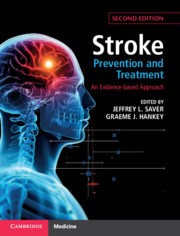Book contents
- Stroke Prevention and Treatment
- Stroke Prevention and Treatment
- Copyright page
- Dedication
- Contents
- Contributors
- Preface
- Part I Foundations
- Chapter 1 Stroke: The Size of the Problem
- Chapter 2 Understanding Evidence
- Part II Systems of Care
- Part III Acute Treatment of Ischaemic Stroke and Transient Ischaemic Attack
- Part IV Acute Treatment of Haemorrhagic Stroke
- Part V Prevention
- Part VI Stroke Rehabilitation and Recovery
- Index
- References
Chapter 2 - Understanding Evidence
from Part I - Foundations
Published online by Cambridge University Press: 15 December 2020
- Stroke Prevention and Treatment
- Stroke Prevention and Treatment
- Copyright page
- Dedication
- Contents
- Contributors
- Preface
- Part I Foundations
- Chapter 1 Stroke: The Size of the Problem
- Chapter 2 Understanding Evidence
- Part II Systems of Care
- Part III Acute Treatment of Ischaemic Stroke and Transient Ischaemic Attack
- Part IV Acute Treatment of Haemorrhagic Stroke
- Part V Prevention
- Part VI Stroke Rehabilitation and Recovery
- Index
- References
Summary
Almost all efficacious stroke treatments confer moderate-to-large benefits, but not staggeringly huge benefits. However, moderate treatment effects can be clinically very worthwhile for the patient. To detect moderate-large treatment benefits, trials must avoid bias and random error. Studies with weak designs (personal experience, observational studies with historical controls, and observational studies with concurrent, non-randomized controls) will not sufficiently control bias and random error to enable reliable discrimination of a true moderate-to-large benefit from false positives and false negatives. Randomized clinical trials are required. 'Ingredients' for a good trial – Proper randomization and concealment of allocation (i.e. clinician cannot have foreknowledge of next treatment allocation)/Outcome evaluation blind to the allocated treatment/Analysis by allocated treatment (including all randomized patients: intention-to-treat)/Large numbers of major outcomes and correspondingly narrow CIs/Conclusion based on pre-specified primary hypothesis and outcome/Chief emphasis on findings in overall study population. Advantages of systematic reviews (over traditional unsystematic, narrative reviews) – Use explicit, well-developed methods to reduce bias/Summarize large amounts of data explicitly/Provide all available data/Increase statistical power and precision/Look for consistencies/inconsistencies/Improve generalizability. Cochrane Reviews – Generally higher quality than other systematic reviews/Periodically updated/Available over internet/Abstracts available free of charge/Full reviews available free of charge in over 100 low- and middle-income countries
Keywords
- Type
- Chapter
- Information
- Stroke Prevention and TreatmentAn Evidence-based Approach, pp. 10 - 34Publisher: Cambridge University PressPrint publication year: 2020



